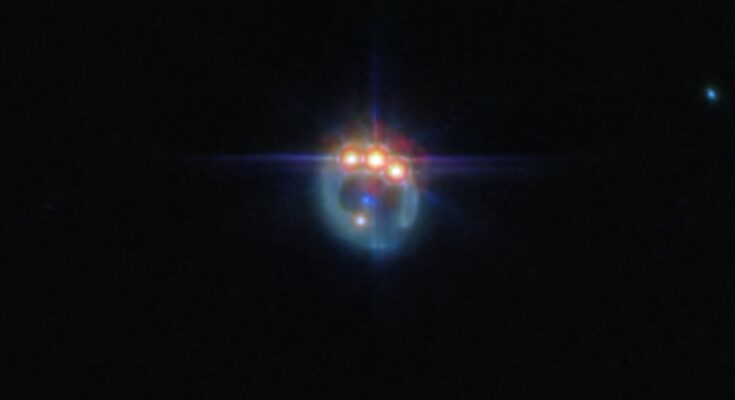The James Webb Space Telescope has captured an image of a cosmic band that looks like sparkling jewels. This ring is formed by a distant shining object called RX J1131-1231, located 6 billion light-years away from Earth.
In the front part of this picture is a large, round galaxy. Its strong gravitational pull bends the light coming from the shining object. This is known as a quasar. The bending effect creates a bright, curved shape. It makes it look like there are two views of the same object, resembling gemstones on a ring.
Gas and dust from quasars create a glowing ring
Quasars shine brightly because they are powered by large amounts of gas and dust that fall into a supermassive black hole at the center of a galaxy. This intense activity makes the area around the black hole glow.
Gravitational lensing happens when a massive object, like a galaxy, bends the light from a more distant source. This effect helps astronomers study areas near the black hole of distant quasars, reported The European Space Agency (ESA) in a statement.
The James Webb telescope found a jeweled ring
This new image from the James Webb Space Telescope shows the gravitational convergence of the quasar known as J1131-1231-RX, located approximately 6 billion light-years from Earth in the constellation of Orion. pic.twitter.com/idDP7GhvN3
— Mohammad Amin Sadriyan (@aminsadriyan) July 9, 2024
“Measurements of the X-ray emission from quasars can provide an indication of how fast the central black hole is spinning and this gives researchers important clues about how black holes grow over time,” ESA officials said in the statement.
In the new image from the James Webb Space Telescope, the elliptical galaxy creating the gravitational lens appears as a small blue dot in the center of the ring. This galaxy works like a natural telescope, making the light from the distant quasar appear larger and clearer. Without this effect, the quasar would be too far away to study.
The black hole grows either by collisions or mergers
A black hole grows differently depending on how it gathers material. If a black hole grows mainly from galaxy collisions and mergers, it forms a stable disc of material around it. This steady flow of material causes the black hole to spin rapidly, according to the ESA.
However, if the black hole grows by pulling in small amounts of material from random directions, it doesn’t spin as fast. Observations show that the black hole in this quasar spins at over half the speed of light. This suggests it has grown through mergers rather than from pulling material in from various directions.
The James Webb Space Telescope used its Mid-Infrared Instrument (MIRI) to capture the new image. This observation is part of a broader study of dark matter and the manner in which it spreads across the universe.



